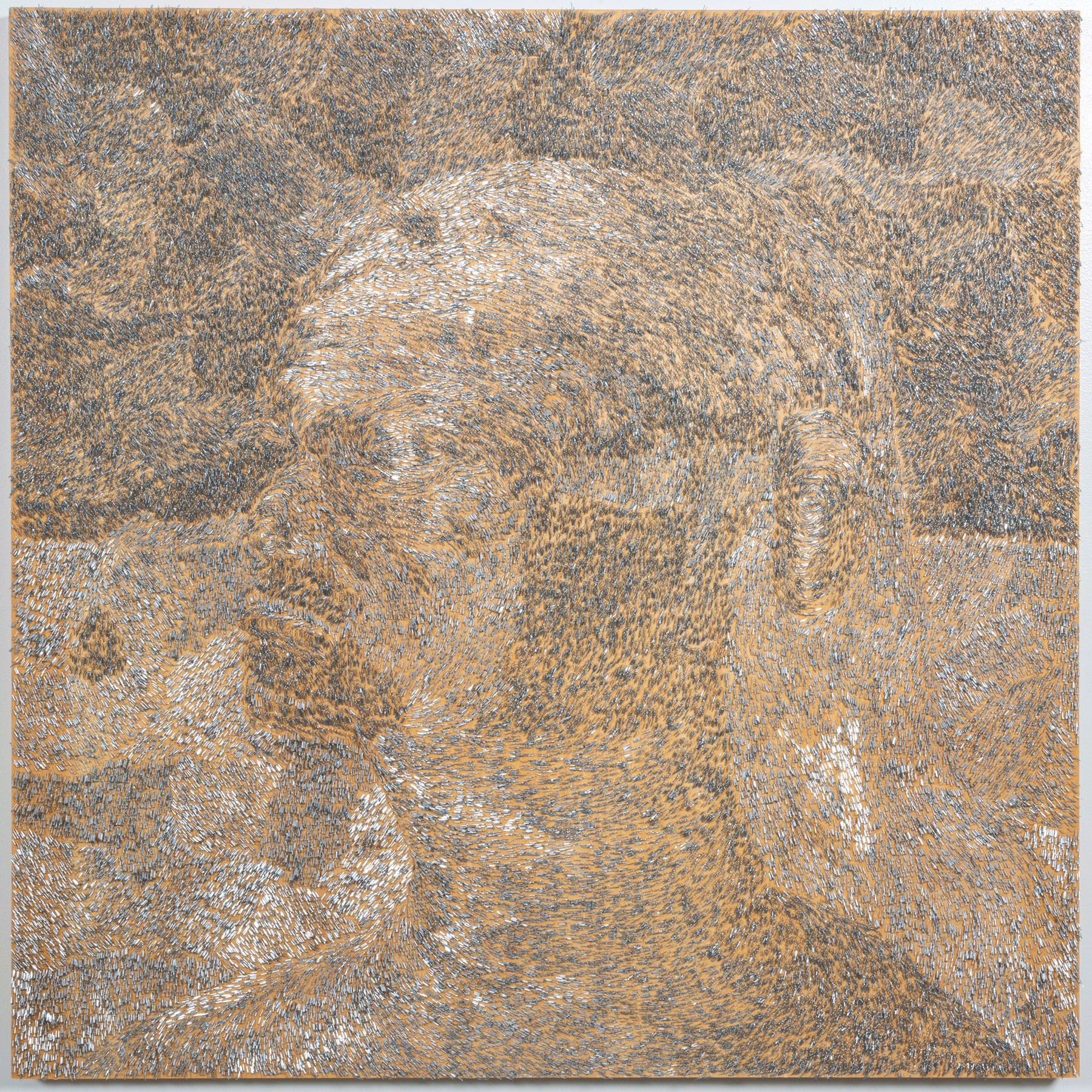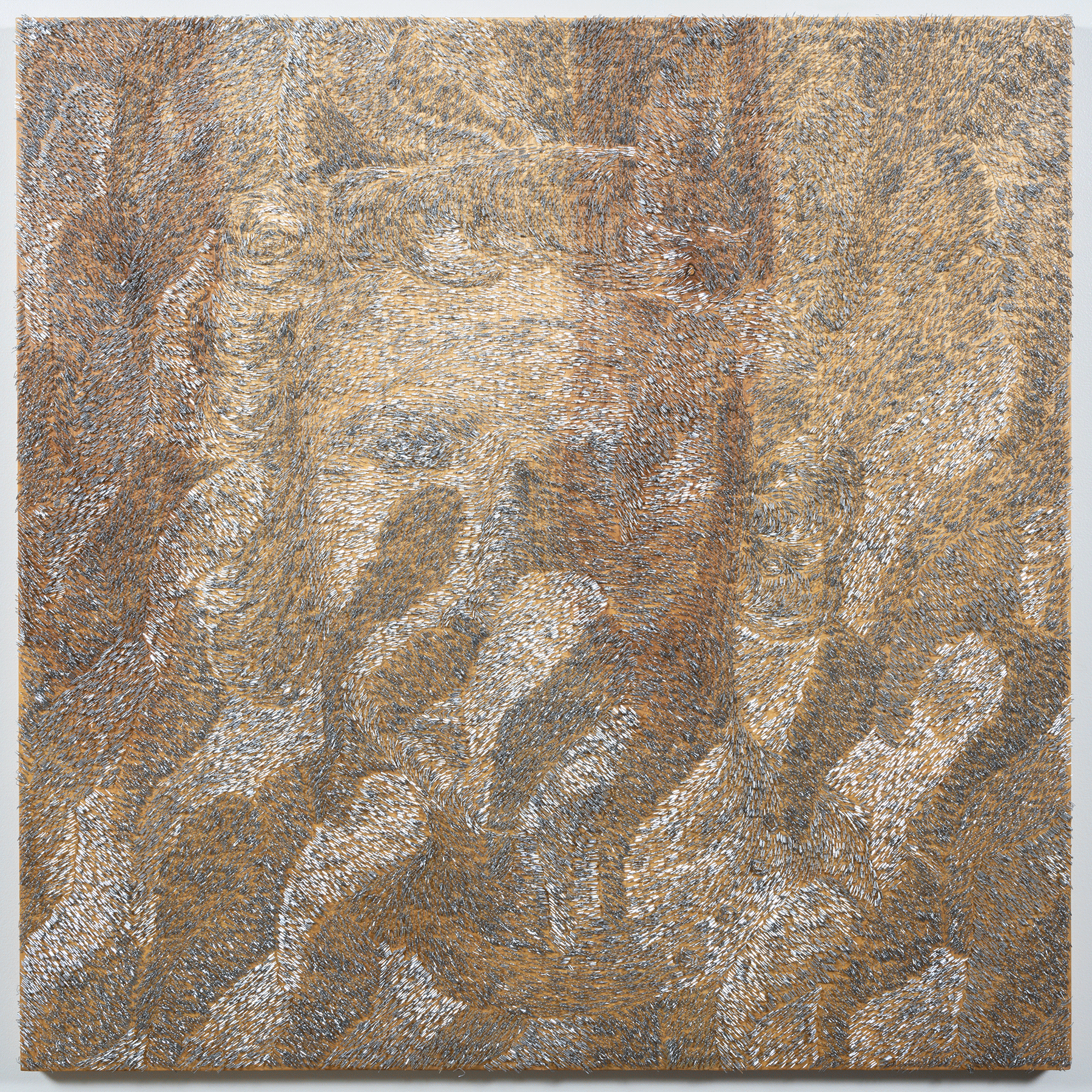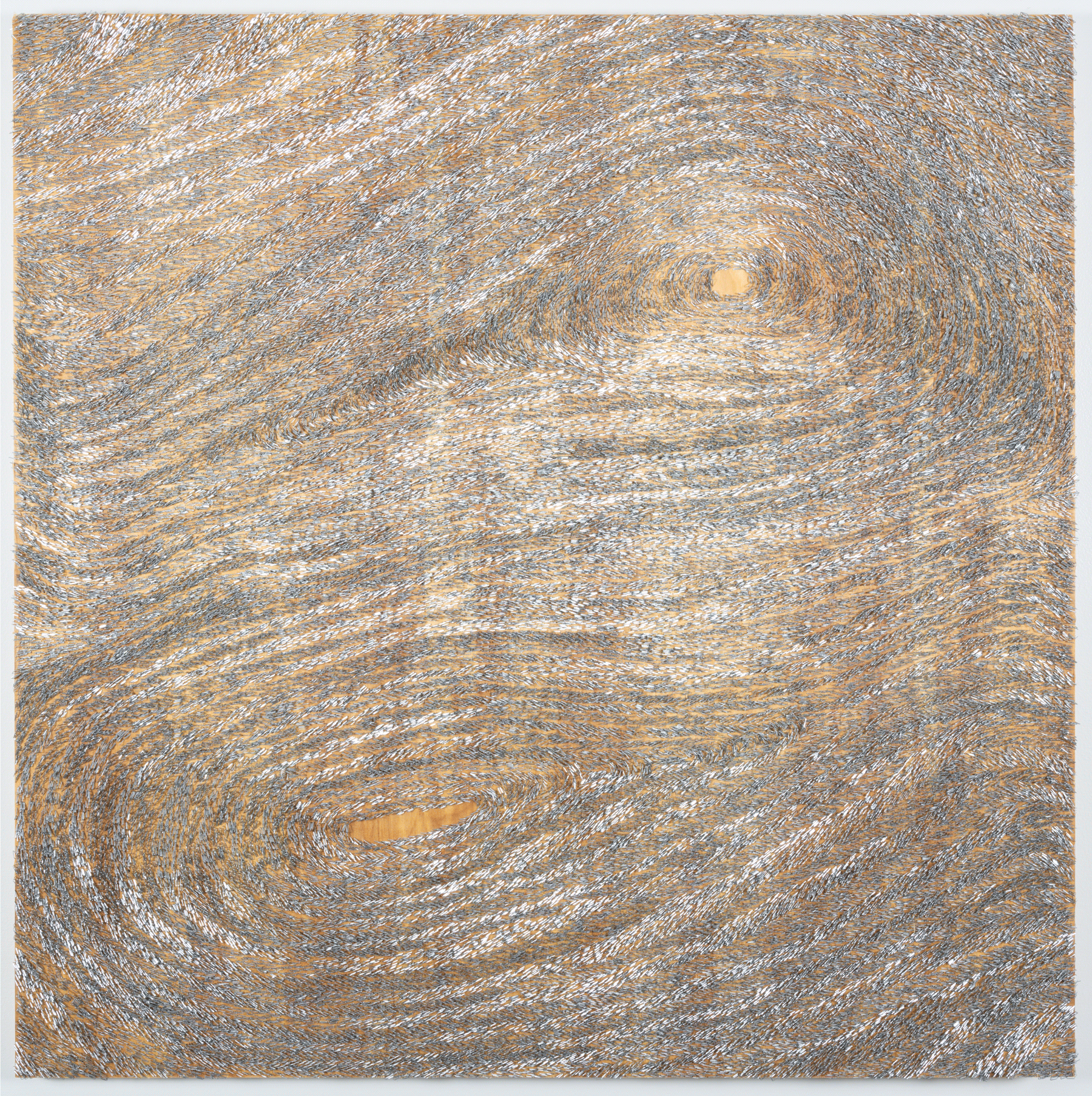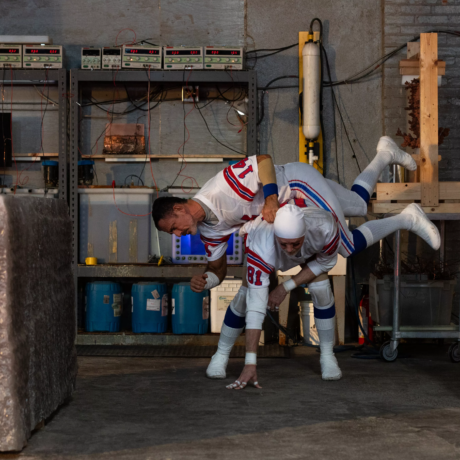
We don’t often give too much thought to quotidian objects like paper bags or postage stamps. They have their uses that make our lives easier, but that’s more or less where our relationship with them ends. For Philadelphia-based artist Wilmer Wilson IV, these found, and domestic objects have long been used as the primary medium of choice in his work to imagine what the implications would be if the skin were augmented with the meaning of everyday objects, he explains. In his latest exhibition, Projections Through the Nictitating Membrane, which is currently on display at Susan Inglett Gallery in New York City until April 20th, Wilson IV has taken the staple, the tiny mainstay of offices, and transformed it into art that is full of depth and texture, both visually and in meaning.
A continuation of sorts from his previous performance art pieces that saw Wilson IV covering himself in items like teeth-whitening strips and postage stamps, this new body of work utilizes 100,000 staples stapled into 4’ by 4’ panels of wood to continue to pursue his fascination with, as he phrases it, “skin’s immutability and what the implications could be if skin changed in some way.” The artist further explains that he is investigating the staple’s role in public places of communication, specifically telephone poles. Though not performance work, he is interested in trying to retain a sense of embodiment that also has the capacity to negotiate with the concept of skin. In his figurative works for the exhibition, Wilson IV states that here is an embodied attempt to suggest more liberatory ways of imagining skin.
Speaking about the title of the show, the artist explains that the nictitating membrane is like a third eyelid. Specifically, it is a translucent membrane that forms an inner eyelid in animals like birds and reptiles and is used as a protective appendage. Wilson IV correlates this to how, during his experiences of embodied distress, he has often thought of what it would feel like to have an organ that protects him in the same manner that the nictitating membrane does for animals.

In 2018, Wilson IV produced a series of pieces that used staples over photographic images to imagine what it would look like if the skin of public communication, that is the copious number of flyers stapled into telephone poles, were to be turned towards reconfiguring the imagined public body. He relates the layering of multiple pieces of paper on telephone poles attached with staples to the concealment of identifying information. By covering the photograph in staples, Wilson IV changes what it looks like, obscuring any recognizable trait in the image and, in the process, anonymizing figures, locations, and objects. Taking a slight departure, for these new pieces, the artist is focusing on the fundamental means of the staple and wood, eliminating the photographic elements previously incorporated.
Wilson IV says that removing the photographs foregrounds the capaciousness of the staples and wood, emphasizing the relationship between the two, or as the artist referred to it, the musculature. The concept of the nictitating membrane suggests accessibility and conversation despite a barrier, something he has increasingly become interested in.
By reframing the staple as the primary medium, the artist aimed to think about the etymology of photography, which is “drawing with light.” When looking at his pieces, that feels like an apt description. Depending on where the viewer is standing or the way the light hits the staple, the reflecting metal gives the appearance of dancing. Speaking about these characteristics, Wilson IV states that there’s a dimensionality that is important to the visual effects of the work. The visuality shifts when the light is shifting, as well as the vantage point in relation to the light. There’s a choreography present in the work, foregrounding the multifaceted marriage between the staple and wood. Though devoid of paint, the amalgamation of the two results in work that, from a distance, takes on the colours that are cast back on it. “It’s not just about moving the light around, it’s also about moving one’s body around the work,” he says.

The exhibition consists of eight pieces that measure 4 feet by 4 feet–with two smaller works, a substantial contrast to the diminutive size of the staples. Looking at them from a distance, viewers may not know that they are produced of small marks. This visual shifting that occurs depending on the positionality of the viewer not only encourages visitors to physically engage with the work in various ways, but as they get closer, they are reminded of the size of the staple. Wilson IV shares that his initial interest in artmaking revolved around minor objects and the compositional device of the skin as an orienting force concerning these objects. He’s long thought about what it would be like to have seemingly arbitrary items as skin. How would they wrap around or function as skin?
In his previous performance pieces in which he covered his body in thousands of postage stamps and walked to a post office, asking to be mailed to freedom, there has always been an element of discomfort. The use of these materials not only asks viewers to challenge their idea of what could function and be defined as skin but also think about the different meanings of skin that are dependent on whom it belongs to. Though discomfort through the application of various mediums has been a recurrent theme in his work, Wilson IV says that for this series of works, he never applied staples to his body as a performance. Instead, he has focused on telephone poles and how, through the application of varied papers, sharing one thing or another, there’s a discursive quality and a site of activity that materializes. For the artist, discomfort emerges in the disintegration of these flyers, signalling a loss of communication. The duality of the staple, both as a sign of life and as a repository for communication, interests Wilson IV, as they enable the infrastructure of various forms of conversation.
There’s an interesting dichotomy present in the relationship between his investigation of skin and the act of marking a surface. Unlike his previous inquiries into locating everyday domestic items as skin, the use of staples requires a puncturing of the surface, a penetration. Both a component of unavoidable violence and healing co-exist within the functionality of staples. Wilson IV explains that throughout the years, he’s tried to iterate the tension that occurs when applying a second skin onto an existing surface and recognize that over time, the degree of density of that original surface is suffocated or obliterated.

Whereas in past work, the staples were confined to the edge of the photograph under the staples, with these new pieces Wilson IV is exploring the use of negative space, which he refers to as breathing room. With these new pieces, the artist is taking advantage of the potentiality of extending the mark-making to the edge of the wood plane. He relates the process of applying staples to the wood to pond scum, the layer of algae that forms over stagnant water. By making use of the negative space, he is circumventing the suffocation of the wood. “I think extending to the edge of the plane has enabled a way of generating a skin without needing to obliterate any semblance of the wood underneath, allowing for moments of breathing,” he says.
For Wilson IV, this new series of works marks a shift and has been a generative space in his artistic career that he looks forward to continuing to create in and explore. Accessibility is crucial to him, as he acknowledges the vicarious understanding of the application of staples and their use in fastening things in forms of public communication. When asked if he will continue to utilize staples in his work, the artist states that in his career, there have been moments during which he was afraid of repeating himself, but during the production of these pieces, he has experienced a breakthrough, allowing him to see the expressive capacity of the staples and wood. This capacity includes investigating the relationships we have with one another through these materials. He says, “I’m interested in the ways these works suggest being with others. What kind of sociality would enable people to share their flyers in a manner that could result in these kinds of images after?”




